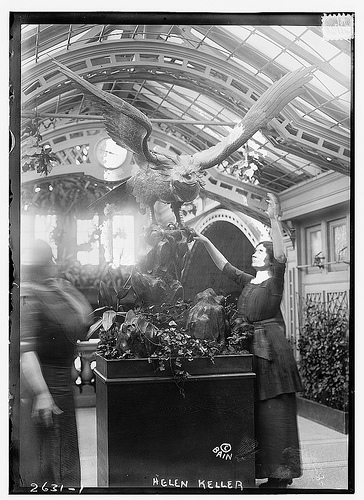The story of Helen Keller is the story of the dark reality that traps you in the absence of your senses. It is also an illustration of the role of language in breaking out of that darkness. Born a healthy child on June 27, 1880 in Alabama, Helen Keller was a perfectly happy baby — until the tender age of 19 months, when she was stricken with a strange illness that “they called acute congestion of the stomach and brain.” The terrible illness left her blind and deaf — “closed my eyes and ears and plunged me into the unconsciousness of a new-born baby,” as she would later write in her autobiography.
Disconnected from the physical world, Helen was trapped in her dark, silent reality (or the lack thereof). She did not even have thoughts or words in her mind, because the tragedy happened before she started talking. She could not learn from her parents like normal children, because she was blind and deaf. There were no special schools at that time for disadvantaged children like her. When she was seven, Helen’s parents contacted Alexander Graham Bell, the inventor of the telephone, who was also an educator of the deaf. Through his help, they found Anne Sullivan to tutor Helen. Anne Sullivan had special methods of making hand signs to spell out objects. Sadly, none of these tricks worked with Helen for a few frustrating months. She could not make the connection between the hand movements and the objects. It looked as though Helen would be doomed to her dark reality for ever. Here is how she made the connection and broke free from darkness. (This block quote is from Helen Keller’s autobiography “The Story of my Life,” which was ffirst published in 1903 and is in the public domain according to the US copyright laws.)
One day, while I was playing with my new doll, Miss Sullivan put my big rag doll into my lap also, spelled “d-o-l-l” and tried to make me understand that “d-o-l-l” applied to both. Earlier in the day we had had a tussle over the words “m-u-g” and “w-a-t-e-r.” Miss Sullivan had tried to impress it upon me that “m-u-g” is mug and that “w-a-t-e-r” is water, but I persisted in confounding the two. In despair she had dropped the subject for the time, only to renew it at the first opportunity. I became impatient at her repeated attempts and, seizing the new doll, I dashed it upon the floor. I was keenly delighted when I felt the fragments of the broken doll at my feet. Neither sorrow nor regret followed my passionate outburst. I had not loved the doll. In the still, dark world in which I lived there was no strong sentiment or tenderness. I felt my teacher sweep the fragments to one side of the hearth, and I had a sense of satisfaction that the cause of my discomfort was removed. She brought me my hat, and I knew I was going out into the warm sunshine. This thought, if a wordless sensation may be called a thought, made me hop and skip with pleasure.
We walked down the path to the well-house, attracted by the fragrance of the honeysuckle with which it was covered. Some one was drawing water and my teacher placed my hand under the spout. As the cool stream gushed over one hand she spelled into the other the word water, first slowly, then rapidly. I stood still, my whole attention fixed upon the motions of her fingers. Suddenly I felt a misty consciousness as of something forgotten — a thrill of returning thought; and somehow the mystery of language was revealed to me. I knew then that “w-a-t-e-r” meant the wonderful cool something that was flowing over my hand. That living word awakened my soul, gave it light, hope, joy, set it free! There were barriers still, it is true, but barriers that could in time be swept away.
The mystery of language is at the genesis of reality; it is what sweeps away the dark barriers standing between us and our conscious awareness of reality. It took Helen Keller out of nothingness into a world of reality, and if it is not the Word in “The Word was God,” I will never know what is.
Photo by The Library of Congress

